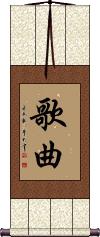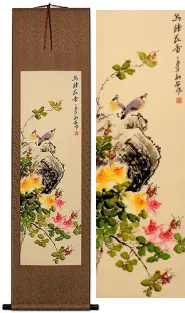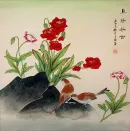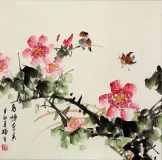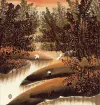Many custom options...
And formats...

Melody Song in Chinese / Japanese...
Buy a Melody Song calligraphy wall scroll here!
Melody / Song
歌曲 is a Chinese, Japanese Kanji, and old Korean Hanja for song, melody, or tune.
There are a few other words that can mean melody, but this is probably the most common and universal.
This in-stock artwork might be what you are looking for, and ships right away...
Gallery Price: $240.00
Your Price: $148.88
Gallery Price: $72.00
Your Price: $39.88
Gallery Price: $120.00
Your Price: $79.88
Gallery Price: $268.00
Your Price: $148.88
Gallery Price: $120.00
Your Price: $79.88
Gallery Price: $108.00
Your Price: $59.88
Gallery Price: $220.00
Your Price: $138.88
Gallery Price: $106.00
Your Price: $58.88
Not the results for melody song that you were looking for?
Below are some entries from our dictionary that may match your melody song search...
| Characters If shown, 2nd row is Simp. Chinese |
Pronunciation Romanization |
Simple Dictionary Definition |
歌曲 see styles |
gē qǔ ge1 qu3 ko ch`ü ko chü kakyoku かきょく |
More info & calligraphy: Melody / Songmelody; tune; song |
原曲 see styles |
genkyoku げんきょく |
original song; original melody |
悲歌 see styles |
bēi gē bei1 ge1 pei ko hika ひか |
to sing with solemn fervor; sad, stirring song; elegy; dirge; threnody (n,vs,adj-no) elegy; dirge; mournful melody |
曲作り see styles |
kyokuzukuri きょくづくり |
musical composition; melody writing; song writing |
Variations: |
kaeuta かえうた |
parody (of a song); new lyrics to an old melody; song parody |
The following table may be helpful for those studying Chinese or Japanese...
| Title | Characters | Romaji (Romanized Japanese) | Various forms of Romanized Chinese | |
| Melody Song | 歌曲 | kakyoku | gē qǔ / ge1 qu3 / ge qu / gequ | ko ch`ü / kochü / ko chü |
Successful Chinese Character and Japanese Kanji calligraphy searches within the last few hours...
